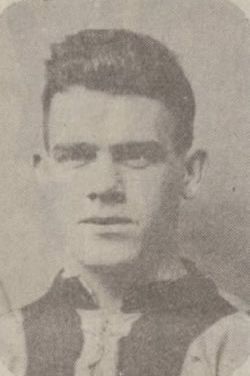Alexander "Alex" Cheyne

The story of Alexander Cheyne is one of twists, turns and chance. He was born in 1907 in the Gorbals. His mother was from Renfrew but his father, at the time a shop-keeper and reserve soldier, a Sergeant-Major, had moved south importantly from Aberdeen. It meant the family had and maintained strong links with the North-East. For example, he was the second of four siblings, the youngest of which would be born just outside Arboath.
So, whilst Alex grew up in Glasgow and played his junior football with Shettleston, when it came to stepping up, an inside-right, to senior at just eighteen it was by signing for The Dons.
In fact Alex would not make it into Aberdeen's First Team for the best part of a year. But once in he was more or less permanent for the next four seasons and clearly becoming increasingly recognised. In 1929 he was selected, admittedly as a late replacement for Tommy Muirhead, against England at Hampden and in the penultimate minute of the game took a corner, he being expert at in-swingers. At the time it was no-score. The corner went direct into goal. Scotland had victory. The crowd of one hundred and ten thousand vocalised its appreciation and, it is said, The Hampden Roar was heard for the first time.
He then went on Scotland's 1929 summer tour to the Continent and then in 1930 was selected away to France. But that was to be the last of his caps and for two reasons. The first was that he, always aware of players' value, asked for a pay-rise from his club but instead was transferred for a very good fee and to Chelsea. It meant that, with the instigation in 1931 by English clubs of a policy of non-release of non-English players for internationals, he, just as only Scots-based players could for eighteen months be considered, found himself in London with the concomitant loss of not just place but fees. The second was that he was also an advocate for players' rights, hugely and opening critical of wage structures, i.e. the maximum wage, and the transfer and retain systems, calling the latter "bondage". He was Bosman before Bosman.
So when Chelsea, having imported a large amount of Scottish talent, amongst the others Alex Jackson, did not get the immediate results it expected and tried to reduce Alex's and the others' wages he, rather than, like Jackson, being squeezed out, simply walked away. In fact he went to France, where professionalism in football had just been legalised, and was not alone. Fellow Scots international Andy Wilson went too. Jackson would join them.
However, despite doubling his money Cheyne did not stay long. After a season and a half he was back, it being said he had not settled, which on the face of it might seem a little perverse even foolish. But behind it all there was probably a much more obvious reason than non-assimilation to French life. At the end of the 1933-34 season he travelled to Aberdeen to marry local girl, Maria Polson, an occasion not without consequences, the first being to return. Indeed, despite offers from other French clubs he decided to return to Chelsea but had to do so cap-in-hand. The club still held his registration. Moreover, even at just just twenty-seven he was then not considered the player he had been and found himself mainly in the reserves until three seasons later at thirty he again asked for a transfer. It was granted but only on payment of a substantial fee, at which point Alex repeated the action of five years earlier but this time within the UK. He walked out, joined Colchester outwith the League's reach and then became player-manager of equally non-league Chelmsford City, that is until war shut the game down.
During the conflict he served in the forces, after which, his playing days over, he and Maria returned to life first back in Aberdeen, working as a book-keeper and coaching, and then in Arbroath, where from 1948 he was managing-director of local coal-company until retirement in 1966 and from 1949 to 1955 managed the town's team. Indeed it was still in Arbroath that in 1983 at seventy-six he passed away to be cremated in Dundee, followed still in Angus town in 1992 by Maria, aged eighty-three.
Birth Locator:
1907 - 61, Camden St., The Gorbals, Glasgow
Residence Locations:
1911 - 61, Camden St., The Gorbals, Glasgow
1918 - 44, Camden St., The Gorbals, Glasgow
1921 - N/A
1930 - 8, Annfield Terrace, Aberdeen
1934 - 3, Belleisle Street, Glasgow
4, Albion House, Vanston Place, London SW6
1939 - 116, Berechurch Road, Colchester, Essex
1950 - 41, Caledonian Place, Aberdeen
1955 - 13, Springbank Terrace, Aberdeen
1983 - N/A
Death Locator:
1983 - Arbroath Infirmary, Arbroath, Angus
Grave Locator:
Back to the Glasgow Southside Trail
or the SFHG Home page